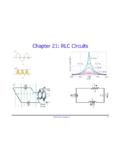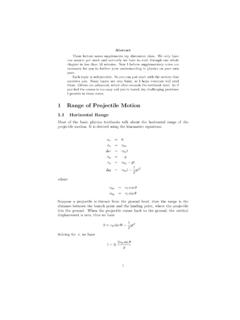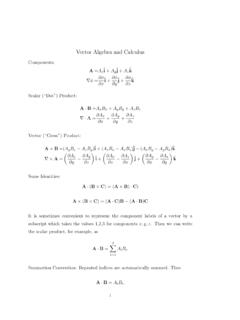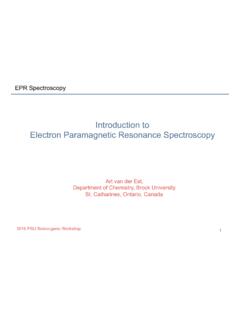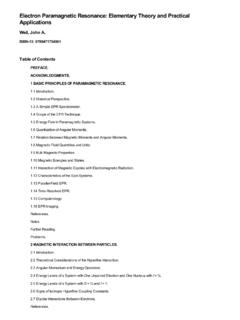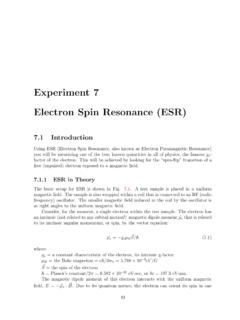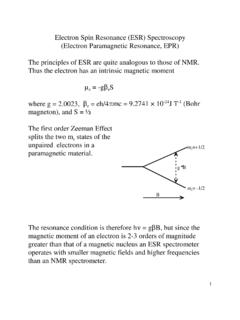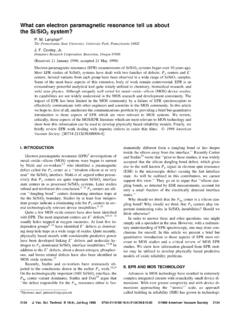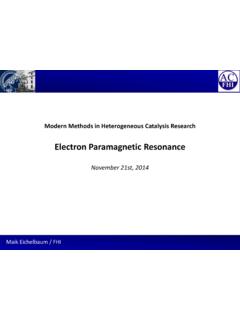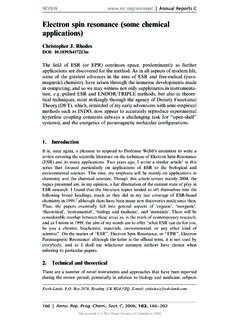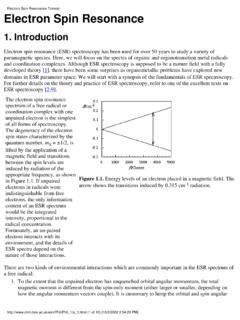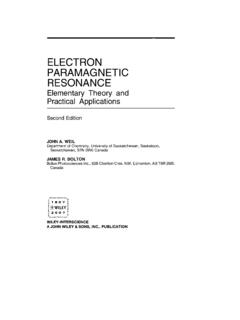Transcription of Electron Paramagnetic Resonance: Theory and Analysis
1 Electron Paramagnetic resonance : Theory and Analysis R. Farnhama, S. Kimb, C. Koob, J. Lawrenceb, S. Hillb aDepartment of Physics, Louisiana State University bDepartment of Physics, University of Florida Electron Paramagnetic resonance (EPR) is a powerful technique that allows researchers to probe fundamental physical properties of molecules. This paper explains the basic motivation and Theory behind EPR. Data Analysis and a particular example of probe design are briefly discussed. Introduction Since the dawn of the quantum era, physicists have ascribed more and more confounding properties to elementary particles. These peculiarities, however far removed from our daily experiences, still have a profound effect in our world. It is a result from quantum physics that electrons have an intrinsic angular momentum, called spin.
2 In contrast to the classical concept of angular momentum, spin is a fundamental property of electrons and is not attributed to any mechanical motion. The magnitude of this spin is always hbar. In addition to spin, electrons also have an inherent magnetic dipole moment; which means electrons act like minute bar magnets. This seemingly bizarre property is, in fact, responsible for the macroscopic phenomena of permanent magnets. This magnetic moment property can be attributed to spin through a classical treatment. By modeling an Electron as a ball of distributed charge with angular momentum equal to the quantum spin, a current flowing in a tiny loop arises1. This current produces a magnetic field, oriented Fig. 1 by the right-hand rule, according to Ampere s Law: (1) Indeed, because of the idiosyncratic definition of current ( the flow of positive charge) the magnetic moment points in the direction opposite of the Electron s spin.
3 There are, however, problems with this model. Electrons have no size attributed to them, but are rather thought as point-like particles. This presents a problem, because points cannot rotate about. Moreover, the preceding explanation assumes some sort of distribution on a ball, but no mention is made as to what it is. It was a while after the inception of Schr dinger s wave equation that this magnetic quantum number was discovered. In the absence of an external magnetic field, the different spin-magnetic moment states for electrons in an atom are nearly degenerate. That is, aside from hyperfine splitting of energy levels due to nucleus- Electron interactions, electrons occupying the same shell and orbital have the same energy. Spectroscopy, historically, was not sufficiently precise to distinguish the energy differences1. A breakthrough was made by performing spectroscopic experiments in a magnetic field.
4 The splitting of a single emission line into several lines corresponded to the splitting of these degenerate energy levels. This splitting, known as the Zeeman Effect, was due to the different magnetic moments obtaining different potentials in a magnetic field. Classically this can be calculated by assuming electrons are magnetic dipoles with North and South Poles and dipole moment . The potential of the dipole in a magnetic field can be Fig. 2 defined by the work done by the torque exerted on the dipole in moving it from an aligned position to its current arrangement: V = 0 d = 0 ( ^B)d = B 0 sin( )d (2) Which equals 2 B if we consider = , corresponding to the potential energy associated with an anti-aligned Electron . However, this picture isn t true to reality because an Electron s magnetic moment is quantized (a direct consequence of the quantization of spin).
5 Moreover, the magnetic moment obeys the Heisenberg uncertainty principle, therefore only one component can be known at a time (the knowledge of a second component vector would allow for the calculation of the third readily through a simple application of the Pythagorean Theorem). Because of the quantized nature of the magnetic moment, the dipole pictured in Fig. 2 could not vary in orientation through continuous angles. Instead it could only assume a few discrete orientations. For an Electron those are either up or down , referring to the direction of the known component of the vector in relation to the external magnetic field. This restriction defines a half cone, where the magnetic moment is known to inhabit. The calculation above can be confirmed experimentally by measuring the energy difference between Electron states for various field strengths and then plotting V versus B.
6 The slope of the line is roughly 2 B where B is the Bohr magneton. Nevertheless, this simple-minded picture doesn t quite work. The 2 in the equation is known as the Land g Factor, and because the way quantum mechanics works, it is actually slight greater than 2. Quantum mechanically the energy difference is more appropriately described by BgB1. Fig. 3 Electron Paramagnetic resonance Electron Paramagnetic resonance , or EPR, exploits the concepts above to probe the inner electronic properties of materials. Imagine a sample of tiny magnetic dipoles; at first any orientation of the dipoles will be equally likely, but if the sample is exposed to an external magnetic field, a preferred direction is chosen. Associated with each dipole is a potential, determined strictly by its orientation with respect to the magnetic field. It turns out that the Maxwell-Bolztmann distribution models the allocation of energies in the previous scenario reasonably well3.
7 In thermal equilibrium, the majority of dipoles will be aligned with the magnetic field, but some will be unaligned. The probability density in energy is given by (3) The energy in this equation is a direct consequence of potential, and is therefore a function of . The simplest sample to consider would be a free Electron gas. Because of the quantum nature of electrons, there would only be two available energy levels, rather than a spectrum. The Maxwell-Bolztmann distribution can still yield a histogram, but it needs to be renormalized before being treated as a probability density function. In thermal equilibrium there will be many electrons in the lowest energy state (aligned with the field) and a few electrons in the highest. The EPR procedure involves shining electromagnetic radiation of fixed microwave frequency through a sample and measuring the absorbance.
8 Meanwhile, the external magnetic field applied to the sample is varied. When V = BgB matches the energy carried by the microwaves, a peak in absorbance appears. This is because there will be many electrons absorbing the waves and jumping from the lower energy state into the excited, anti-aligned state. Samples under scrutiny at the Hill lab are much more varied and exotic than free- Electron gases. Chemistry has allowed the adept manipulation of a compound s net magnetic moment. This molecular magnetic moment arises from unpaired electrons in the constituent atoms. These compounds are called single molecular magnets, frequently referred to as SMMs. SMMs can be studied through EPR because of the magnetization response they afford. Although single molecular magnets can exhibit more than two spin energy levels, they can still be studied through similar methods, yielding a variety of peaks in the EPR spectrum.
9 From the absorbance data their magnetic moments and quantum numbers can be reconstructed using a phenomenological Hamiltonian, which takes into account the Zeeman splitting and other finer interactions between the parts of the compound. SMMs display a variety of phenomena, such as anisotropy. Anisotropy occurs when there is a preferred direction for the magnetic moment of the electrons in the molecule, caused by the very structure of the compound. The preferred direction is often called the easy axis, and the directions perpendicular to it are collectively called the hard plane. Another interesting phenomenon displayed by SMMs is the tunneling of magnetic moment. This event is characterized by the magnetic moment of the molecule going from one state to another without passing through any intermediary states, which would be otherwise forbidden due to prohibitive energy costs.
10 SMMs have sparked a great deal of interest because of their remarkable tunneling properties and their behavior as quantum systems2. These features make single molecular magnets attractive components for quantum computers, whether it be for storage media, or switching in logical components. Procedure and Operation Envisioning and designing an EPR experiment is far from easy. The first hurdle to clear is finding a source for a strong and uniform magnetic field. However, with the advent of superconducting magnets, very strong magnetic fields can be created and maintained with minimal energy input. The only problem posed by superconducting magnets is their requirement for low temperatures to behave in the superconducting regime. The actual superconducting coil is kept refrigerated in a bath of liquid helium at temperatures as low as 4K.

